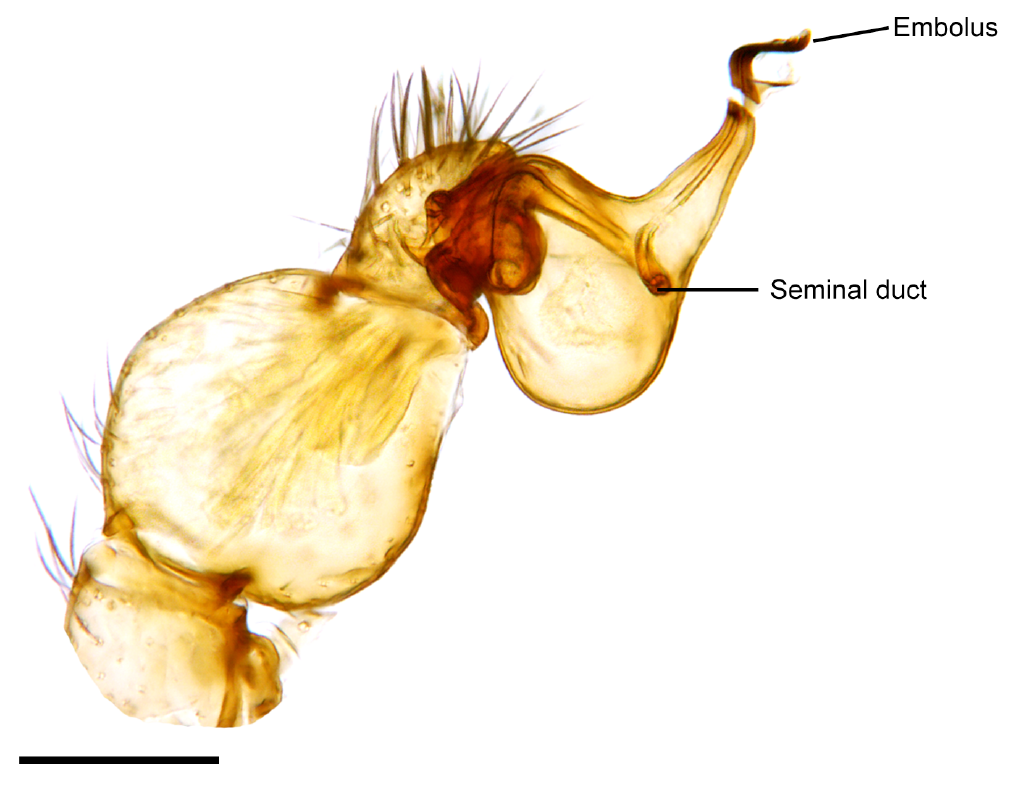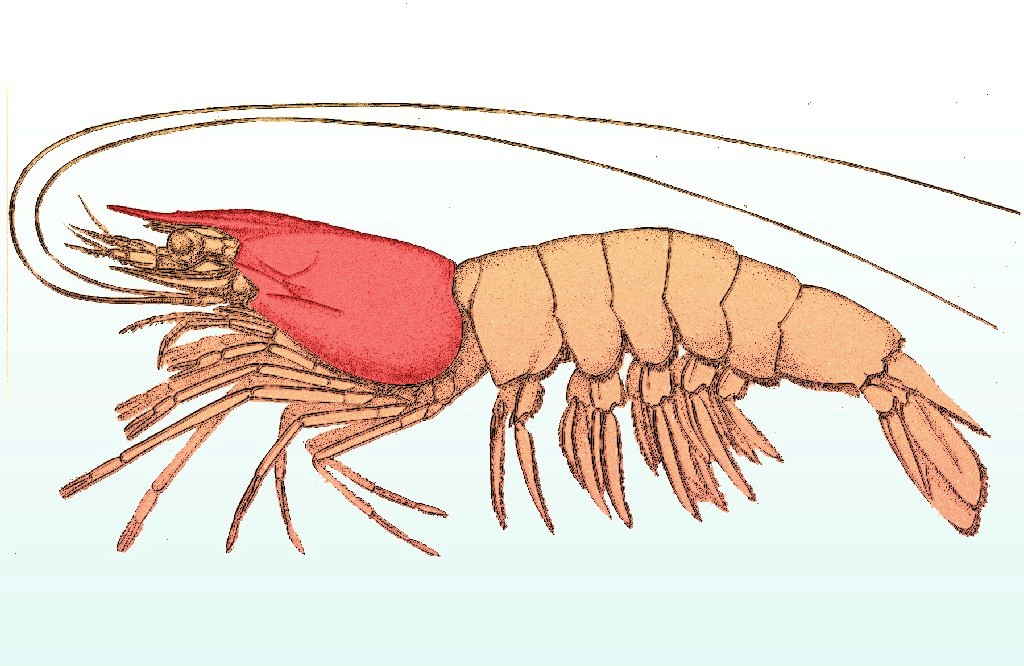|
Palaeoperenethis Thaleri
''Palaeoperenethis'' is an extinct monotypic genus of nursery web spider family Pisauridae, and at present, it contains the single species ''Palaeoperenethis thaleri''. The genus is solely known from Early Eocene, Ypresian Okanagan Highlands deposits in the Cariboo region of British Columbia, Canada. History and classification ''Palaeoperenethis thaleri'' is known only from one fossil, the holotype, number "ROM31304" consisting of part and counterpart impressions that is currently residing in the paleontological collections in the Royal Ontario Museum, Toronto, Ontario, Canada. It is an adult male individual preserved as a compression fossil in the fine-grained lacustrian rock and thus has been flattened from its dimensions in life. The compression specimen was mentioned in publication by paleoichthylologist Mark Wilson (1977) while discussing the paleoecology of the Horsefly Shales Lagerstätte fossil site. ''P. thaleri'' was first studied by Paul A. Selden and David Penney, ... [...More Info...] [...Related Items...] OR: [Wikipedia] [Google] [Baidu] |
Paul A
Paul may refer to: *Paul (given name), a given name (includes a list of people with that name) * Paul (surname), a list of people People Christianity * Paul the Apostle (AD c.5–c.64/65), also known as Saul of Tarsus or Saint Paul, early Christian missionary and writer * Pope Paul (other), multiple Popes of the Roman Catholic Church * Saint Paul (other), multiple other people and locations named "Saint Paul" Roman and Byzantine empire * Lucius Aemilius Paullus Macedonicus (c. 229 BC – 160 BC), Roman general *Julius Paulus Prudentissimus (), Roman jurist * Paulus Catena (died 362), Roman notary * Paulus Alexandrinus (4th century), Hellenistic astrologer * Paul of Aegina or Paulus Aegineta (625–690), Greek surgeon Royals * Paul I of Russia (1754–1801), Tsar of Russia *Paul of Greece (1901–1964), King of Greece Other people * Paul the Deacon or Paulus Diaconus (c. 720 – c. 799), Italian Benedictine monk * Paul (father of Maurice), the father of Mau ... [...More Info...] [...Related Items...] OR: [Wikipedia] [Google] [Baidu] |
Horsefly Shales
Horse-flies or horseflies are true flies in the family Tabanidae in the insect order Diptera. They are often large and agile in flight, and only the female horseflies bite animals, including humans, to obtain blood. They prefer to fly in sunlight, avoiding dark and shady areas, and are inactive at night. They are found all over the world except for some islands and the polar regions (Hawaii, Greenland, Iceland). Both horse-flies and botflies (Oestridae) are sometimes referred to as gadflies. Adult horse-flies feed on nectar and plant exudates; the males have weak mouthparts and only the females bite animals to obtain enough protein from blood to produce eggs. The mouthparts of females are formed into a stout stabbing organ with two pairs of sharp cutting blades, and a spongelike part used to lap up the blood that flows from the wound. The larvae are predaceous and grow in semiaquatic habitats. Female horse-flies can transfer blood-borne diseases from one animal to another ... [...More Info...] [...Related Items...] OR: [Wikipedia] [Google] [Baidu] |
Pisauridae
Nursery web spiders (Pisauridae) is a family of araneomorph spiders first described by Eugène Simon in 1890. They resemble wolf spiders (Lycosidae) except for several key differences. Wolf spiders have two very prominent eyes in addition to the other six, while a nursery web spider's eyes are all about the same size. Additionally, female nursery web spiders carry their egg sacs with their jaws and pedipalps instead of attaching them to their spinnerets as wolf spiders do. When the eggs are about to hatch, a female spider builds a nursery "tent", places her egg sac inside, and stands guard outside, hence the family's common name. Like the wolf spiders, however, the nursery web spiders are roaming hunters that don't use webs for catching prey. Species occur throughout the world except for extremely dry or cold environments, and are common just about everywhere. Many can walk on the surface of still bodies of water and may even dive beneath the surface temporarily to escape enem ... [...More Info...] [...Related Items...] OR: [Wikipedia] [Google] [Baidu] |
Trechaleidae
Trechaleidae (''tre-kah-LEE-ih-dee'') is a family of araneomorph spiders first described by Eugène Simon in 1890, and includes about 140 described species in 16 genera. They all live in Central and South America except for '' Shinobius orientalis'', which is endemic to Japan. Other names for the family are longlegged water spiders and fishing spiders. Genera , the World Spider Catalog accepts the following genera: *'' Amapalea'' Silva & Lise, 2006 – Brazil *''Barrisca'' Chamberlin & Ivie, 1936 – South America, Panama *''Caricelea'' Silva & Lise, 2007 – Peru *''Cupiennius'' Simon, 1891 – Mexico to northwestern South America *''Dossenus'' Simon, 1898 – Trinidad, South America *''Dyrines'' Simon, 1903 – South America, Panama *'' Enna'' O. Pickard-Cambridge, 1897 – South America, Central America, Mexico *''Heidrunea'' Brescovit & Höfer, 1994 – Brazil *''Hesydrus'' Simon, 1898 – South America, Central America *''Neoctenus'' Simon, 1897 – Brazil, ... [...More Info...] [...Related Items...] OR: [Wikipedia] [Google] [Baidu] |
Pedipalp
Pedipalps (commonly shortened to palps or palpi) are the second pair of appendages of chelicerates – a group of arthropods including spiders, scorpions, horseshoe crabs, and sea spiders. The pedipalps are lateral to the chelicerae ("jaws") and anterior to the first pair of walking legs. Overview Pedipalps are composed of six segments or articles: the coxa, the trochanter, the femur, the short patella, the tibia, and the tarsus. In spiders, the coxae frequently have extensions called maxillae or gnathobases, which function as mouth parts with or without some contribution from the coxae of the anterior legs. The limbs themselves may be simple tactile organs outwardly resembling the legs, as in spiders, or chelate weapons ( pincers) of great size, as in scorpions. The pedipalps of Solifugae are covered in setae, but have not been studied in detail. Comparative studies of pedipalpal morphology may suggest that leg-like pedipalps are primitive in arachnids. At present, t ... [...More Info...] [...Related Items...] OR: [Wikipedia] [Google] [Baidu] |
Opisthosoma
The opisthosoma is the posterior part of the body in some arthropods, behind the prosoma ( cephalothorax). It is a distinctive feature of the subphylum Chelicerata (arachnids, horseshoe crabs and others). Although it is similar in most respects to an abdomen (and is often referred to as such), the opisthosoma is differentiated by its inclusion of the respiratory organs ( book lungs or book gills) and the heart. Segments The number of segments and appendages on the opisthosoma vary. Scorpions have 13, but the first is only seen during its embryological development. Other arachnids have fewer; harvestmen, for instance, have only ten. In general, appendages are absent or reduced, although in horseshoe crabs they persist as large plate-like limbs, called opercula or branchiophores, bearing the book gills, and that function in locomotion and gas exchange. In most chelicerates the opisthosomal limbs are greatly reduced and persist only as specialized structures, such as the silk-p ... [...More Info...] [...Related Items...] OR: [Wikipedia] [Google] [Baidu] |
Carapace
A carapace is a dorsal (upper) section of the exoskeleton or shell in a number of animal groups, including arthropods, such as crustaceans and arachnids, as well as vertebrates, such as turtles and tortoises. In turtles and tortoises, the underside is called the plastron. Crustaceans In crustaceans, the carapace functions as a protective cover over the cephalothorax (i.e., the fused head and thorax, as distinct from the abdomen behind). Where it projects forward beyond the eyes, this projection is called a rostrum. The carapace is calcified to varying degrees in different crustaceans. Zooplankton within the phylum Crustacea also have a carapace. These include Cladocera, ostracods, and isopods, but isopods only have a developed "cephalic shield" carapace covering the head. Arachnids In arachnids, the carapace is formed by the fusion of prosomal tergites into a single plate which carries the eyes, ocularium, ozopores (a pair of openings of the scent gland of Opilione ... [...More Info...] [...Related Items...] OR: [Wikipedia] [Google] [Baidu] |
International Society Of Arachnology
The International Society of Arachnology (ISA) promotes the study of arachnids and the exchange of information among researchers in this field. It acts as an umbrella organisation for regional societies and individuals interested in spiders, and related animals, and organises an ''International Congress'' every three years. History Conception The idea of arachnologists coming together for scientific meetings stems from the German zoologist Hermann Wiehle in 1959 . He encouraged Wolfgang Crome (Berlin) and Ernst Kullmann (Bonn) in this matter and a subsequent meeting of the German Zoological Society in Bonn in 1960 was used as a platform for the first arachnological meeting; with about 20 (mostly German) scientists in attendance. A second meeting, again associated with the German Zoological Society, followed in Saarbrücken in 1961 organised by Otto Kraus, and attracted additional international participation. The third meeting, again organised by Otto Kraus, was held in Frankfurt ... [...More Info...] [...Related Items...] OR: [Wikipedia] [Google] [Baidu] |
Konrad Thaler
Konrad Thaler (born 19 December 1940 in Innsbruck, Austria – died 11 June 2005) was an Austrian arachnologist. Peter J. Schwendinger Peter J. Schwendinger (born 27 April 1959 in Dornbirn, Austria) is an Austrian arachnologist. He graduated from Innsbruck University in 1985, and in 1990 with a PhD, where he studied with Konrad Thaler. He was a lecturer at Innsbruck University, f ..., other Austrian arachnologist, studied with Konrad Thaler, in Innsbruck University. Tributes The specific epithet of the spider species '' Palaeoperenethis thaleri'' was designated by P. Selden and D. Penney in honor of the late Dr. Konrad Thaler, past president of the International Society of Arachnology. References External links Obituary Austrian arachnologists 1940 births 2005 deaths 20th-century Austrian zoologists {{Austria-scientist-stub ... [...More Info...] [...Related Items...] OR: [Wikipedia] [Google] [Baidu] |
Perenethis
''Perenethis'' is a genus of nursery web spiders that was first described by Ludwig Carl Christian Koch in 1878. Species it contains six species, found in Africa, Asia, Australia, and Papua New Guinea: *'' Perenethis dentifasciata'' (O. Pickard-Cambridge, 1885) – Pakistan or India *'' Perenethis fascigera'' (Bösenberg & Strand, 1906) – China, Korea, Japan *''Perenethis simoni'' (Lessert, 1916) – Africa, Comoros *''Perenethis sindica'' ( Simon, 1897) – India, Sri Lanka, Nepal, China, Philippines *''Perenethis symmetrica'' (Lawrence, 1927) – Africa *''Perenethis venusta ''Perenethis'' is a genus of nursery web spiders that was first described by Ludwig Carl Christian Koch in 1878. Species it contains six species, found in Africa, Asia, Australia, and Papua New Guinea: *'' Perenethis dentifasciata'' (O. Pickard ...'' L. Koch, 1878 ( type) – India, Myanmar, Thailand, Singapore, Philippines, Japan, Papua New Guinea, Australia (Queensland, Western Australia) See als ... [...More Info...] [...Related Items...] OR: [Wikipedia] [Google] [Baidu] |
Greek Language
Greek ( el, label= Modern Greek, Ελληνικά, Elliniká, ; grc, Ἑλληνική, Hellēnikḗ) is an independent branch of the Indo-European family of languages, native to Greece, Cyprus, southern Italy (Calabria and Salento), southern Albania, and other regions of the Balkans, the Black Sea coast, Asia Minor, and the Eastern Mediterranean. It has the longest documented history of any Indo-European language, spanning at least 3,400 years of written records. Its writing system is the Greek alphabet, which has been used for approximately 2,800 years; previously, Greek was recorded in writing systems such as Linear B and the Cypriot syllabary. The alphabet arose from the Phoenician script and was in turn the basis of the Latin, Cyrillic, Armenian, Coptic, Gothic, and many other writing systems. The Greek language holds a very important place in the history of the Western world. Beginning with the epics of Homer, ancient Greek literature includes many works of l ... [...More Info...] [...Related Items...] OR: [Wikipedia] [Google] [Baidu] |




